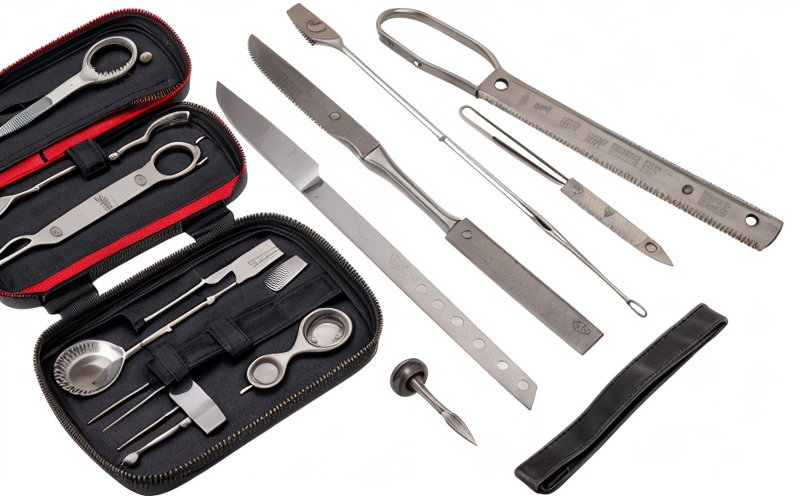Fatigue Resistance Testing of Articulated Surgical Tools
The fatigue resistance testing of articulated surgical tools is a critical process to ensure that instruments designed for complex movements can withstand repeated use over extended periods. This type of testing helps medical device manufacturers identify potential weaknesses in their designs, ensuring safety and reliability during surgical procedures.
Articulated surgical tools are used extensively across various medical specialities such as orthopedics, neurosurgery, and general surgery. These tools are designed to mimic the natural movement of human joints, enabling precise and controlled manipulation within confined spaces. The fatigue resistance testing process is essential for ensuring that these instruments can endure the rigors of daily use without compromising their functionality or integrity.
The test typically involves subjecting the tool to a series of cyclic motions that simulate real-world usage patterns. This can include bending, twisting, and other movements that are characteristic of surgical procedures. The testing apparatus often includes a fatigue testing machine capable of replicating these actions with controlled precision.
During the test, engineers monitor various parameters such as force applied, angle of deflection, and number of cycles completed before failure occurs. Compliance with international standards like ISO 14972 is crucial for ensuring that the instruments meet safety requirements. The results from this testing are used to refine designs and improve durability, thereby enhancing patient outcomes.
One common challenge in fatigue resistance testing lies in accurately simulating the specific movements required by different surgical procedures. Manufacturers must work closely with experienced laboratories to ensure they capture all relevant variables that could impact performance. Proper specimen preparation is also vital; it involves selecting appropriate materials and ensuring consistent geometry across samples.
The importance of accurate data cannot be overstated when interpreting results from fatigue resistance tests. Compliance officers should pay particular attention to how these findings influence decisions regarding product certification and marketing claims. By investing in robust testing protocols, companies can build trust with healthcare providers who rely on their products for critical procedures.
- Compliance with ISO 14972
- Simulation of real-world movements
- Consistent specimen preparation
- Accurate data interpretation and reporting
Industry Applications
The application of fatigue resistance testing extends beyond just surgical tools; it plays a vital role in ensuring the longevity and reliability of other medical devices as well. For instance, arthroscopic instruments used during joint surgeries require similar levels of precision and durability to withstand high-pressure environments inside the body.
In the dental sector, drills that perform intricate procedures within small cavities need to be highly resistant to fatigue due to their constant use in tight spaces. Similarly, endoscopy tools designed for viewing internal organs from outside the body must also demonstrate exceptional fatigue resistance if they are to remain effective throughout prolonged examinations.
For orthopedic surgeons conducting minimally invasive procedures, retractors used to hold open tissue while operating need reliable articulation mechanisms that can maintain their shape under stress. Properly executed fatigue testing ensures these tools retain their form and function even after repeated use.
The aerospace industry shares some similarities with medical device manufacturing in terms of demanding performance standards for lightweight components subjected to extreme conditions. Just as aircraft structures must endure repeated takeoffs and landings, surgical instruments need to maintain integrity during countless repetitions of delicate maneuvers.
Quality and Reliability Assurance
Ensuring consistent quality in medical device manufacturing is paramount given the high stakes involved. Fatigue resistance testing contributes significantly towards maintaining these standards by providing clear insights into potential weak points within product designs. Here are several key factors that contribute to reliable outcomes:
- Standardized Testing Procedures: Adherence to recognized international standards ensures consistent results across different laboratories.
- Precision Instruments: High-precision equipment allows for accurate measurement of forces and angles exerted during testing.
- Data Analysis Tools: Advanced software helps analyze large datasets collected from multiple tests, identifying trends that may indicate design flaws.
- Repeatable Results: Consistent test conditions allow manufacturers to compare results over time, tracking improvements or regressions in product performance.
By incorporating these elements into their quality assurance processes, medical device companies can build confidence among healthcare professionals who use their products daily. This not only enhances overall patient safety but also strengthens brand reputation within the competitive medical technology market.
Competitive Advantage and Market Impact
In today's highly competitive medical technology landscape, demonstrating a commitment to quality through rigorous testing can set a company apart from its competitors. By investing in comprehensive fatigue resistance testing for their articulated surgical tools, manufacturers can:
- Gain Competitive Edge: Superior performance and durability translate into better patient outcomes, which is increasingly becoming a deciding factor for healthcare providers when selecting suppliers.
- Enhance Reputational Standing: A track record of meeting stringent quality standards fosters trust among both clinicians and patients alike.
- Pave the Way for Innovation: Insights gained from testing can guide future product development, leading to more advanced solutions tailored specifically to evolving clinical needs.
As regulatory requirements continue to evolve, especially in light of increasing global standards like EU MDR (Medical Device Regulation), compliance becomes not just a legal obligation but also a strategic imperative. Companies that excel at meeting these demands will find themselves better positioned to navigate market challenges and capitalize on emerging opportunities.





